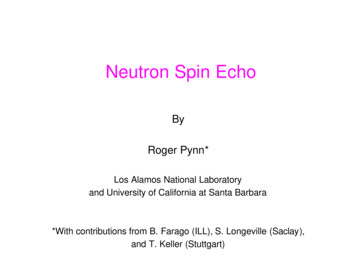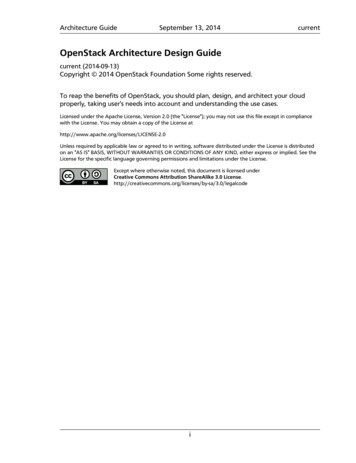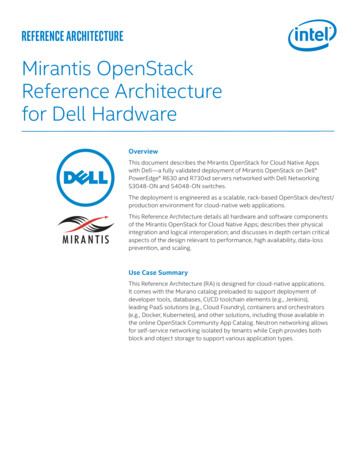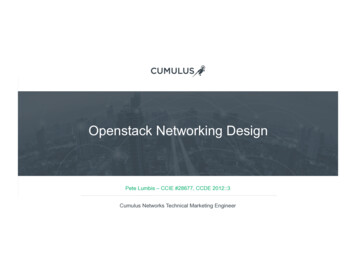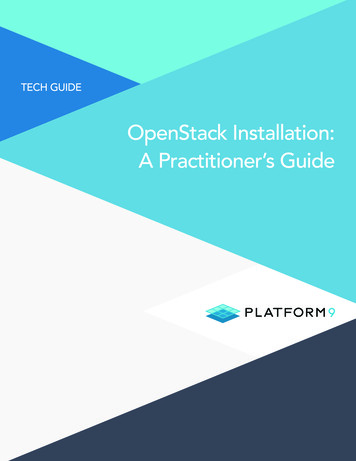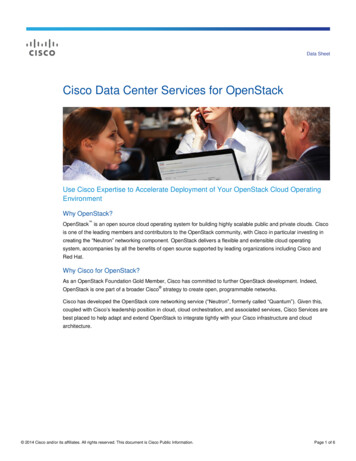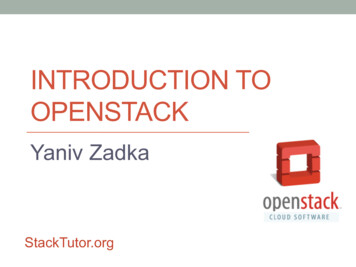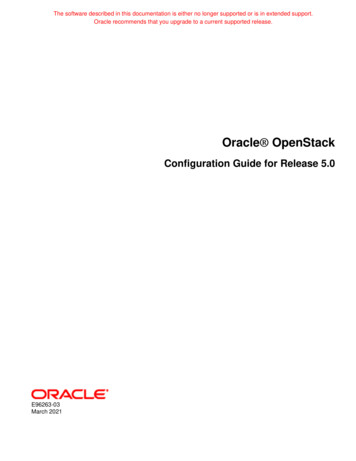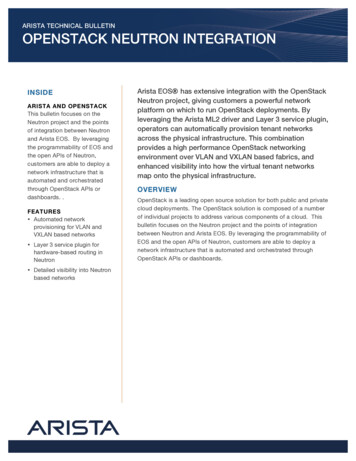
Transcription
ARISTA TECHNICAL BULLETINOPENSTACK NEUTRON INTEGRATIONINSIDEARISTA AND OPENSTACKThis bulletin focuses on theNeutron project and the pointsof integration between Neutronand Arista EOS. By leveragingthe programmability of EOS andthe open APIs of Neutron,customers are able to deploy anetwork infrastructure that isautomated and orchestratedthrough OpenStack APIs ordashboards. .FEATURES Automated networkprovisioning for VLAN andVXLAN based networks Layer 3 service plugin forhardware-based routing inNeutron Detailed visibility into Neutronbased networksArista EOS has extensive integration with the OpenStackNeutron project, giving customers a powerful networkplatform on which to run OpenStack deployments. Byleveraging the Arista ML2 driver and Layer 3 service plugin,operators can automatically provision tenant networksacross the physical infrastructure. This combinationprovides a high performance OpenStack networkingenvironment over VLAN and VXLAN based fabrics, andenhanced visibility into how the virtual tenant networksmap onto the physical infrastructure.OVERVIEWOpenStack is a leading open source solution for both public and privatecloud deployments. The OpenStack solution is composed of a numberof individual projects to address various components of a cloud. Thisbulletin focuses on the Neutron project and the points of integrationbetween Neutron and Arista EOS. By leveraging the programmability ofEOS and the open APIs of Neutron, customers are able to deploy anetwork infrastructure that is automated and orchestrated throughOpenStack APIs or dashboards.
ARISTA MODULAR LAYER 2 (ML2) DRIVER FOR VLANEnd-to-end automated provisioning of tenant networks requires configuration of devices from multiple vendors,such as configuring both Open vSwitch (OVS) on a hypervisor and an Arista top of rack (ToR) switch. This has ledto the development of the Neutron Modular Layer 2 (ML2) plugin, allowing multiple Layer 2 drivers to be used in asingle plugin.The Neutron ML2 Plugin separates the decision of what resources to allocate to a given tenant network (done by a“type driver”) from how that information is then provisioned across the virtual and physical infrastructure (done by“mechanism drivers”). Multiple mechanism drivers can be registered in parallel for different parts of yourinfrastructure. For example, one mechanism driver can be used for a virtual switch like OVS, while another canmanage your Arista physical network infrastructure. The ML2 plugin architecture allows mechanism drivers to bechanged independently, or for new mechanism drivers to be added in the future, as the needs of the networkchange. Arista contributed to the design and implementation of the mechanism driver infrastructure within theML2 plugin, as well as wrote an Arista mechanism driver for automating the provisioning of an Arista physicalnetwork.The Arista ML2 mechanism driver enables Neutron to automate VLAN provisioning on Arista switches. ThroughLLDP, the switches are aware of what compute nodes are connected. As VM instances are created on computenodes, the Ethernet trunk port between the ToR and compute node is automatically configured to allow therequired VLANs. The Arista ML2 mechanism driver provisions VLANs in parallel with the virtual switch driver, suchas OVS, that configures the VLANs on the virtual switch on the hypervisor host, and provides tight integrationbetween network and compute provisioning.ARISTA TECHNICAL BULLETINOPENSTACK NEUTRON INTEGRATION 2
Figure 1: Arista ML2 Mechanism DriverIn addition to provisioning the Neutron networks on switches, Arista EOS has commands that can be run on theswitches themselves to help with troubleshooting and monitoring Neutron network configurations. For instance, anetwork administrator can determine what VLAN ID corresponds to a Neutron network quickly using the switchcommand line interface (CLI).EXAMPLESshow openstack networksThis command shows the networks configured in Neutron, VLAN IDs associated with them, and a VNI mapping ifit exists (described in detail later in this on:RegionOneTenantName:adminARISTA TECHNICAL BULLETINOPENSTACK NEUTRON INTEGRATION 3
meNetworkIdSegTypeSegIdMapstoVNI- ‐- ‐- ‐- ‐- ‐- ‐- ‐- ‐- ‐- ‐- ‐- ‐- ‐- ‐- ‐- ‐- ‐- ‐- ‐- ‐- ‐- ‐- ‐- ‐- ‐- ‐- ‐- ‐- ‐- ‐- ‐- ‐- ‐- ‐- ‐- ‐- ‐- ‐- ‐- ‐- ‐- ‐- ‐- ‐- ‐- ‐- ‐- ‐- ‐- ‐- ‐- ‐- ‐- ‐- ‐- ‐- ‐- ‐- ‐- ‐- ‐- ‐- ‐- ‐- ‐- ‐- ‐- ‐- ‐- ‐- ‐- ‐- ‐- ‐public2db1eeb6- ‐18f7- ‐4747- ‐bee0- rkIdSegTypeSegIdMapstoVNI- ‐- ‐- ‐- ‐- ‐- ‐- ‐- ‐- ‐- ‐- ‐- ‐- ‐- ‐- ‐- ‐- ‐- ‐- ‐- ‐- ‐- ‐- ‐- ‐- ‐- ‐- ‐- ‐- ‐- ‐- ‐- ‐- ‐- ‐- ‐- ‐- ‐- ‐- ‐- ‐- ‐- ‐- ‐- ‐- ‐- ‐- ‐- ‐- ‐- ‐- ‐- ‐- ‐- ‐- ‐- ‐- ‐- ‐- ‐- ‐- ‐- ‐- ‐- ‐- ‐- ‐- ‐- ‐- ‐- ‐- ‐- ‐- ‐- ‐testnetwork1c74cb1f- ‐ee00- ‐46d2- ‐9550- ‐9ca0bf04326fvlan110211102private29d42c5d- ‐93f8- ‐4f76- ‐b57c- ‐474afba9f5c9vlan110011100show openstack vmsThis command shows the virtual machines currently active in Nova, the host, and the Neutron network that isassigned to the c920b7VMNameVMIdHostNetworkName- ‐- ‐- ‐- ‐- ‐- ‐- ‐- ‐- ‐- ‐- ‐- ‐- ‐- ‐- ‐- ‐- ‐- ‐- ‐- ‐- ‐- ‐- ‐- ‐- ‐- ‐- ‐- ‐- ‐- ‐- ‐- ‐- ‐- ‐- ‐- ‐- ‐- ‐- ‐- ‐- ‐- ‐- ‐- ‐- ‐- ‐- ‐- ‐- ‐- ‐- ‐- ‐- ‐- ‐- ‐- ‐- ‐- ‐- ‐- ‐- ‐- ‐- ‐- ‐- ‐- ‐- ‐- ‐- ‐- ‐- ‐- ‐- ‐- ‐- ‐TestVM936a8f48- ‐b817- ‐4c56- ‐83bf- ‐40fe7ab26bc6stack1testnetworkARISTA ML2 DRIVER FOR HARDWARE BASED VXLANThe Arista ML2 Driver also supports provisioning for VXLAN-based architectures. A VXLAN-base network deliverslayer 2 connectivity for VMs with layer 3 scalability at the leaf and spine. With hardware VTEP support on manyArista switches, a VXLAN network can be predefined between the leaf switches. This allows the standard ML2VLAN type driver to configure VLANs on the trunks between the switches and compute nodes (as discussed in theML2 section), but use VXLAN tunnels between racks.ARISTA TECHNICAL BULLETINOPENSTACK NEUTRON INTEGRATION 4
Using this model, VXLAN encapsulation and decapsulation is done at wire speed in hardware on the switch,removing the performance penalty from using a software-based VTEP. The Arista EOS VXLAN implementationsupports VXLAN VNI to VLAN mapping to be done centrally rather than on every switch. The central VXLAN VNImapping also manages the VNIs present on each switch, only adding them as needed to support the VLANs inuse on the switch.Figure 2 shows a VXLAN deployment scenario across a layer 3 leaf-spine network. In this scenario a central EOSinstance assigns and maps VXLAN VNIs to the VLANs configured on the ports connected to the host. This createsa virtual layer 2 network overlay across a routed IP infrastructure. When traffic leaves a VM, it is tagged with aparticular VLAN. Once the traffic arrives at the switch, the VLAN tag is removed and it is encapsulated on theVXLAN overlay network to be carried across the layer 3 network to the switch connected to the destination VM.When the encapsulated traffic reaches the destination VTEP, the VXLAN header is removed and then sent on theappropriate Ethernet port, tagged with the VLAN. The Arista ML2 driver behaves in the same manner as before.No additional configuration is needed on the OpenStack nodes since the communication between the computenodes and switch still uses VLAN tagging and EOS handles the VXLAN mapping.Arista’s VXLAN implementation allows for unicast flooding of Broadcast, Unknown, and Multicast (BUM) trafficthrough head-end replication (HER), and automatic distribution of VTEP flood lists. This removes the need formulticast or static VTEP configuration on the switches.Figure 2: Arista Hardware VXLAN provisioningEXAMPLESARISTA TECHNICAL BULLETINOPENSTACK NEUTRON INTEGRATION 5
show openstack networksAs described above, this command not only shows the Neutron networks, but the VLAN to VNI for each apstoVNI- ‐- ‐- ‐- ‐- ‐- ‐- ‐- ‐- ‐- ‐- ‐- ‐- ‐- ‐- ‐- ‐- ‐- ‐- ‐- ‐- ‐- ‐- ‐- ‐- ‐- ‐- ‐- ‐- ‐- ‐- ‐- ‐- ‐- ‐- ‐- ‐- ‐- ‐- ‐- ‐- ‐- ‐- ‐- ‐- ‐- ‐- ‐- ‐- ‐- ‐- ‐- ‐- ‐- ‐- ‐- ‐- ‐- ‐- ‐- ‐- ‐- ‐- ‐- ‐- ‐- ‐- ‐- ‐- ‐- ‐- ‐- ‐- ‐- ‐public2db1eeb6- ‐18f7- ‐4747- ‐bee0- rkIdSegTypeSegIdMapstoVNI- ‐- ‐- ‐- ‐- ‐- ‐- ‐- ‐- ‐- ‐- ‐- ‐- ‐- ‐- ‐- ‐- ‐- ‐- ‐- ‐- ‐- ‐- ‐- ‐- ‐- ‐- ‐- ‐- ‐- ‐- ‐- ‐- ‐- ‐- ‐- ‐- ‐- ‐- ‐- ‐- ‐- ‐- ‐- ‐- ‐- ‐- ‐- ‐- ‐- ‐- ‐- ‐- ‐- ‐- ‐- ‐- ‐- ‐- ‐- ‐- ‐- ‐- ‐- ‐- ‐- ‐- ‐- ‐- ‐- ‐- ‐- ‐- ‐- ‐testnetwork1c74cb1f- ‐ee00- ‐46d2- ‐9550- ‐9ca0bf04326fvlan110211102private29d42c5d- ‐93f8- ‐4f76- ‐b57c- ‐474afba9f5c9vlan110011100show openstack config networks vni mappingThis command shows the VLAN to VNI mappings that are provisioned across the network. They are onlyconfigured in one location and propagated to the imappingRegion:RegionOneVLANrangeVNIrange- ‐- ‐- ‐- ‐- ‐- ‐- ‐- ‐- ‐- ‐- ‐- ‐- ‐- ‐- ‐- ‐- ‐- ‐- ‐- ‐- ‐- ‐- ‐- ‐- ‐- ‐- ‐1100- ‐119911100- ‐11199ARISTA TECHNICAL BULLETINOPENSTACK NEUTRON INTEGRATION 6
show interfaces vxlan 1In this command you may notice that the mappings are learned dynamically, as opposed to static configuration onthe VTEP. We are using head-end replication on this VTEP to forward BUM traffic to the other VTEPs that aremembers of a 003.3.3.311023.3.3.3ARISTA LAYER 3 SERVICE PLUGINIn the OpenStack Juno release, Arista has added an Arista layer 3 service plugin. This plugin replaces the existingNeutron layer 3 service plugin. It creates switched virtual interfaces (SVIs) on TOR switches when a virtual router iscreated in Neutron. Once configured, the hardware switch becomes the default gateway for the VMs, and allrouting can be done in hardware on the switch, instead of in software at the Neutron network node. In a multi-linkaggregation (MLAG) environment the switches can be configured to use virtual IP addresses to leverage VirtualARP (VARP) for first hop redundancy. Pushing the routing functionality into a hardware switch can provideincreased performance and scalability versus the default software based router.In Figure 3, when a virtual router is created in Neutron, the Arista layer 3 service plugin configures both ToRswitches with IP addresses in the subnet assigned to the Neutron network. For example, if the subnet is1.1.1.0/24 for VLAN 100, then ToR1 would have a VLAN 100 SVI created with IP address of 1.1.1.253 and a virtualIP of 1.1.1.1. ToR2 would also have an SVI created, but with IP addres of 1.1.1.254 and virtual IP of 1.1.1.1. Whenthe VMs are instantiated, they would use 1.1.1.1 as their default gateway, and use the hardware ToR switch forrouting.When a VXLAN overlay is used between the ToR switches, the VXLAN routing functionality of Arista EOS allowsthe layer 3 functionality to work across VXLAN VNIs as well.ARISTA TECHNICAL BULLETINOPENSTACK NEUTRON INTEGRATION 7
Figure 3: Arista Layer 3 Service PluginCONCLUSIONThe Arista OpenStack solution provides a number of ways for administrators to orchestrate their Arista switches.The ML2 plugin automates the provisioning of VLANs on Arista switches and can optionally be combined with anArista VXLAN overlay to provide the functionality across a Layer 3 core. With the Arista layer 3 service plugin, ahardware switch can serve as the routing gateway, even in a VXLAN environment where VXLAN routing isrequired.The ability to orchestrate the physical network devices provisioning within the OpenStack solution is a significantachievement for the market. Arista has consistently led the way in providing new and open functionality to theOpenStack community and has an extensive set of features designed to address the needs of scaling anOpenStack cloud.ARISTA TECHNICAL BULLETINOPENSTACK NEUTRON INTEGRATION 8
Table 1: Minimum supported software versionsOpenStack Integration FeatureMinimum Supported OpenStackVersionMinimum Supported EOS VersionArista ML2 Mechanism Driver for VLANHavana4.12.1Arista Layer 3 Service PluginJuno4.14.5FArista ML2 Driver for Hardware basedVXLANJuno4.14.5FSanta Clara—Corporate Headquarters5453 Great America ParkwaySanta Clara, CA 95054Tel: 408-547-5500www.arista.comIreland—International Headquarters4130 Atlantic AvenueWestpark Business CampusShannonCo. Clare, IrelandSingapore—APAC Administrative Office9 Temasek Boulevard#29-01, Suntec Tower TwoSingapore 038989Copyright 2015 Arista Networks, Inc. All rights reserved. CloudVision, and EOS areregistered trademarks and Arista Networks is a trademark of Arista Networks, Inc. All othercompany names are trademarks of their respective holders. Information in this document issubject to change without notice. Certain features may not yet be available. Arista Networks,Inc. assumes no responsibility for any errors that may appear in this document.02/15ARISTA TECHNICAL BULLETINOPENSTACK NEUTRON INTEGRATION 9
OpenStack is a leading open source solution for both public and private cloud deployments. The OpenStack solution is composed of a number of individual projects to address various components of a cloud. This bulletin focuses on the Neutron project and the points of integration between Neutron and Arista EOS.

